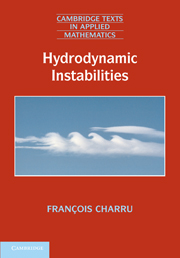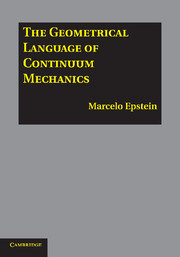Refine search
Actions for selected content:
8126 results in Fluid dynamics and solid mechanics
INTRODUCTION TO STRUCTURAL DYNAMICS AND AEROELASTICITY, SECOND EDITION
-
- Book:
- Introduction to Structural Dynamics and Aeroelasticity
- Published online:
- 05 June 2012
- Print publication:
- 22 August 2011, pp xxiii-xxiv
-
- Chapter
- Export citation
2 - Mechanics Fundamentals
-
- Book:
- Introduction to Structural Dynamics and Aeroelasticity
- Published online:
- 05 June 2012
- Print publication:
- 22 August 2011, pp 6-29
-
- Chapter
- Export citation
Appendix A - Lagrange's Equations
-
- Book:
- Introduction to Structural Dynamics and Aeroelasticity
- Published online:
- 05 June 2012
- Print publication:
- 22 August 2011, pp 231-240
-
- Chapter
- Export citation
Frontmatter
-
- Book:
- Introduction to Structural Dynamics and Aeroelasticity
- Published online:
- 05 June 2012
- Print publication:
- 22 August 2011, pp i-vi
-
- Chapter
- Export citation
5 - Aeroelastic Flutter
-
- Book:
- Introduction to Structural Dynamics and Aeroelasticity
- Published online:
- 05 June 2012
- Print publication:
- 22 August 2011, pp 175-230
-
- Chapter
- Export citation
Contents
-
- Book:
- Introduction to Structural Dynamics and Aeroelasticity
- Published online:
- 05 June 2012
- Print publication:
- 22 August 2011, pp vii-x
-
- Chapter
- Export citation
SURFACE TEMPERATURE RECONSTRUCTION BASED ON THE THERMOCAPILLARY EFFECT
- Part of
-
- Journal:
- The ANZIAM Journal / Volume 52 / Issue 2 / October 2010
- Published online by Cambridge University Press:
- 19 August 2011, pp. 146-159
-
- Article
-
- You have access
- Export citation
BOUNDS FOR HARDY DIFFERENCES
- Part of
-
- Journal:
- The ANZIAM Journal / Volume 52 / Issue 2 / October 2010
- Published online by Cambridge University Press:
- 08 August 2011, pp. 218-224
-
- Article
-
- You have access
- Export citation

Hydrodynamic Instabilities
-
- Published online:
- 05 August 2011
- Print publication:
- 30 June 2011

The Geometrical Language of Continuum Mechanics
-
- Published online:
- 05 August 2011
- Print publication:
- 26 July 2010
STABILITY ANALYSIS OF A LOTKA–VOLTERRA TYPE PREDATOR–PREY SYSTEM INVOLVING ALLEE EFFECTS
- Part of
-
- Journal:
- The ANZIAM Journal / Volume 52 / Issue 2 / October 2010
- Published online by Cambridge University Press:
- 03 August 2011, pp. 139-145
-
- Article
-
- You have access
- Export citation
CONTACT PROBLEMS FOR NONLINEARLY ELASTIC MATERIALS: WEAK SOLVABILITY INVOLVING DUAL LAGRANGE MULTIPLIERS
- Part of
-
- Journal:
- The ANZIAM Journal / Volume 52 / Issue 2 / October 2010
- Published online by Cambridge University Press:
- 03 August 2011, pp. 160-178
-
- Article
-
- You have access
- Export citation
Preface
-
- Book:
- Essentials of Heat Transfer
- Published online:
- 05 June 2012
- Print publication:
- 01 August 2011, pp xvii-xx
-
- Chapter
- Export citation
Frontmatter
-
- Book:
- Essentials of Heat Transfer
- Published online:
- 05 June 2012
- Print publication:
- 01 August 2011, pp i-vi
-
- Chapter
- Export citation
Nomenclature
-
- Book:
- Essentials of Heat Transfer
- Published online:
- 05 June 2012
- Print publication:
- 01 August 2011, pp 661-662
-
- Chapter
- Export citation
8 - Heat Transfer in Thermal Systems
-
- Book:
- Essentials of Heat Transfer
- Published online:
- 05 June 2012
- Print publication:
- 01 August 2011, pp 659-660
-
- Chapter
- Export citation
Appendix C - Tables of Thermochemical and Thermophysical Properties
-
- Book:
- Essentials of Heat Transfer
- Published online:
- 05 June 2012
- Print publication:
- 01 August 2011, pp 680-716
-
- Chapter
- Export citation
Subject Index
-
- Book:
- Essentials of Heat Transfer
- Published online:
- 05 June 2012
- Print publication:
- 01 August 2011, pp 717-722
-
- Chapter
- Export citation
4 - Radiation
-
- Book:
- Essentials of Heat Transfer
- Published online:
- 05 June 2012
- Print publication:
- 01 August 2011, pp 324-423
-
- Chapter
- Export citation
Acknowledgments
-
- Book:
- Essentials of Heat Transfer
- Published online:
- 05 June 2012
- Print publication:
- 01 August 2011, pp xxi-xxii
-
- Chapter
- Export citation
